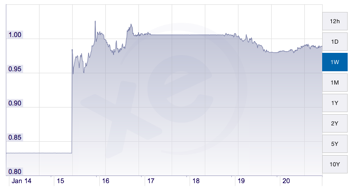“Every man lives by exchanging.” Adam Smith
Currency is the blood in the veins of economies. It is the fundamental denominator of all trade. But there are so many veins, arteries and capillaries in the world economy that the circulation of currency is seldom constant, and at times it becomes palsied.
The latest tremors in the global circulation of currency have been felt in the Swiss franc. Until last week its relationship with the euro had been one of the few immovable forces in the global currency-trading environment, fixed at around €1.20 to the franc since summer 2011. But then last Thursday the Swiss National Bank removed its currency peg, sparking a sudden, near-20% surge in the value of the franc against the euro.
Euros per Swiss franc, January 14 to January 20, 2015
Source: XE.com
But this move was simply a symptom of some highly volatile times for global currency and commodities markets. The European Central Bank decides on Thursday whether to embark on a committed round of Quantitative Easing in which the Bank creates new euros to buy financial assets, in an effort to stimulate inflation.
We can expect this to cause the euro to slide further against the Swiss franc and others, most notably the US dollar, which in turn has risen almost 18% since last May against a basket of other currencies. Meanwhile, the depressed oil price has caused a crisis in the rouble, as discussed here last month [see related article below]. Having traded at less than 34 roubles to the dollar six months ago, one dollar would now cost a Russian twice as much, at 65 roubles this week.
So what has all this got to do with football? Well, European football has a single market just like the Eurozone. Except that UEFA stretches geographically from Iceland in the west to Kazakhstan and the Russia in the east. Although the euro is of course the dominant method of exchange within UEFA, the 54 national associations within it span 27 different currencies from the Albanian Lek to the Polish Zloty. Fully half the nations do not use the currency that UEFA denominates its central distributions in.
All clubs throughout the UEFA zone operate in a single market for transfers and for central UEFA prize-money and broadcasting distributions. So this can cause problems. Because as we have seen, the pistons of global foreign-exchange markets move at differing speeds.
Let’s say a Swiss club agreed to purchase a midfielder from the Russian Premier League on January 17 last year. Let’s say for simplicity’s sake the payment schedule was over five equal annual instalments and that the deal was agreed for $10 million.
The initial $2 million would have cost the Swiss club CHF1.88 million in the first down-payment but CHF2 million 12 months later. That’s not such a big deal, maybe. But switch it the other way round and it really is. Were the Russian club to have been buying in dollars from the Swiss then the player becomes cripplingly expensive. The first year’s payment would have been RUB67 million. The next year’s? RUB130 million – virtually double the cost for the same player.
Now this kind of currency exposure is common to all international trade. Except that football now has an extra layer of regulatory requirements in the shape of UEFA’s Financial Fair Play rules. Even as someone who generally dislikes regulatory interventions into markets, I absolutely believe in FFP as having sound motives. I also recognise that it is a very well thought out framework that is properly governed by a well intentioned regulator in UEFA. But as with all regulatory interventions, in practice some unintended consequences have arisen that could not have been anticipated before.
It would be far too complicated for UEFA’s consideration of clubs’ accounts under FFP to be currency neutral. The complexity of working out how each individual transaction a club undertakes would have cost if denominated in euros or Swiss francs would be prohibitive for UEFA to complete in a timely fashion. Necessarily it considers clubs’ profit-and-loss accounts in the currency in which those clubs generally trade.
But as we have seen, there are wild gyrations in currency markets that can make a seemingly prudent transaction become unaffordable through forces beyond the control of the club. The answer would be for clubs to insulate themselves with currency-hedging arrangements that protect against movements in currencies. Under such arrangements it is the firm offering the insurance policy that takes the hit, not the club. But no one offers currency-hedging insurance for free, and anyone who takes out this policy must pay a large sum that UEFA then includes in the FFP breakeven calculation. It means clubs operating outside of the eurozone are put at a disadvantage to those within it who can trade freely in their own currency with clubs in 26 other countries.
This brings into question whether UEFA ought to consider deducting such currency-hedging arrangements from the FFP calculation. Because if clubs eschew such sensible expenditure over fears of missing the breakeven target and instead take on the risk themselves they could be in big trouble when the foreign-exchange market moves against them. FFP aims to encourage sensible behaviour among regulated clubs. Taking a look at excluding sensible expenditure like currency-hedging arrangements from the breakeven calculation would surely fit that objective.
Related article: http://www.insideworldfootball.com/matt-scott/16053-matt-scott-russian-2018-organisers-face-taxing-task-as-inflation-takes-off
Journalist and broadcaster Matt Scott wrote the Digger column for The Guardian newspaper for five years and is now a columnist for Insideworldfootball. Contact him at moc.l1714021937labto1714021937ofdlr1714021937owedi1714021937sni@t1714021937tocs.1714021937ttam1714021937.

